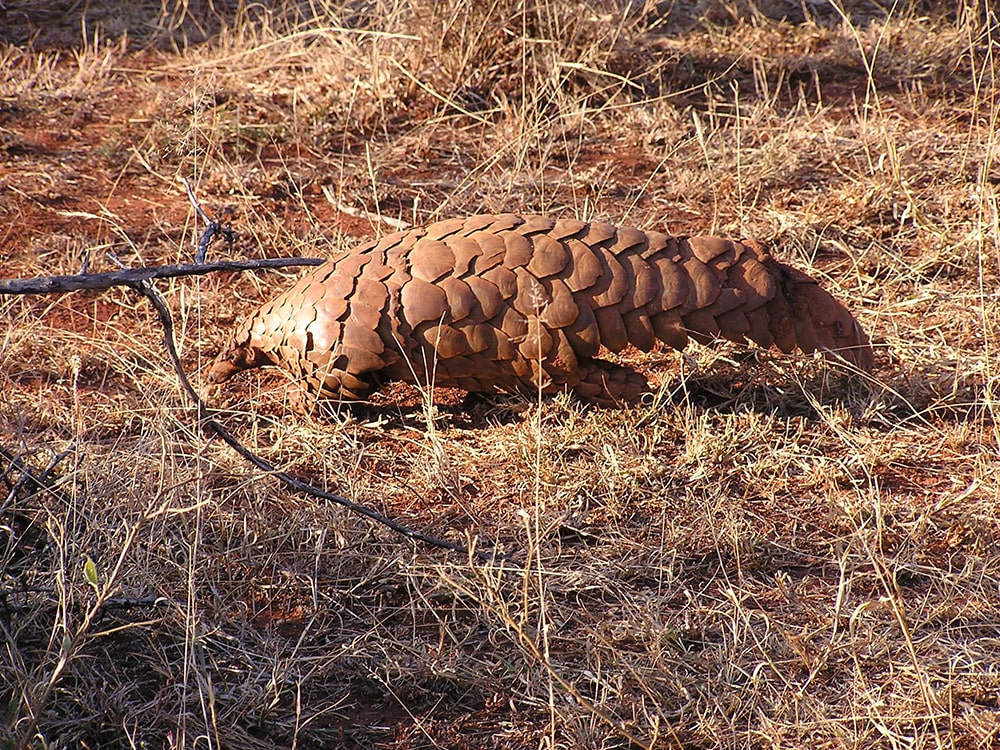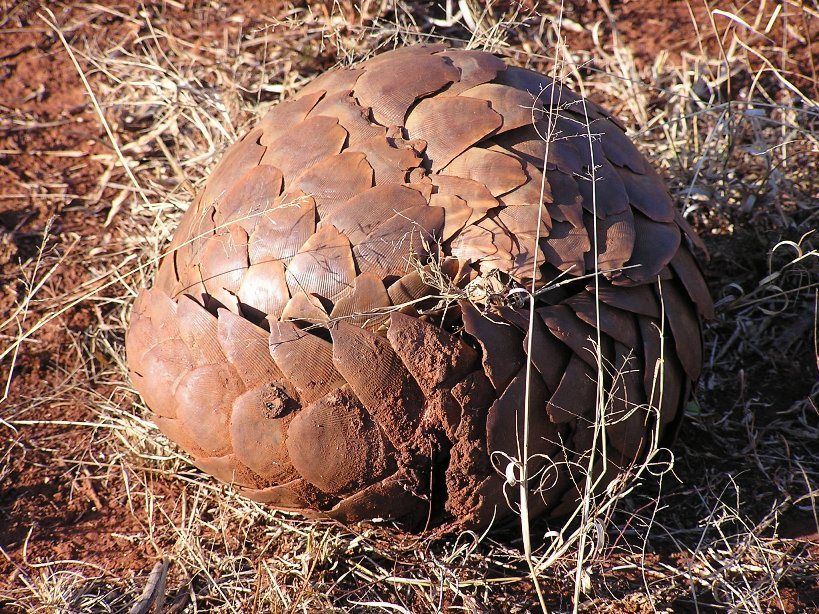Most of you have probably never heard the name pangolin before! So, it is safe to assume that you know nothing about the pangolins! Well, let’s rectify that!
Often mistaken for reptiles, the Pangolins are the only mammals with scales. They are also called scaly anteaters.
The name comes from the word “pengguling” from Malay (The national language of Malaysia, Brunei, and Indonesia) and means “something that rolls up.”
At first glance, the pangolins look more like an anteater ready for a medieval battle, where the scales act as armor!
The Pangolins Family
There is a total of 8 species of pangolins, which are all listed as threatened in the IUCN Red List of Threatened Species.
The pangolins are scattered on two continents:
- Africa: Black-bellied, White-bellied, Giant Ground, and Temminck’s Ground Pangolins.
- Asia: Chinese, Sunda, Philippine, and Indian Pangolins.
Interesting Facts
The habitat of the pangolins consists of the sandy soil of the woodlands and the savannas, preferably close to the water. These scaly anteaters are found in Southern, Central, and East Africa as well as China and Southeast Asia.
The size of the pangolins varies considerably depending on the species. The largest is the Giant Ground Pangolin, which weighs between 30-40 lbs (14-18 kg), and the smallest, is the Black-bellied Pangolin which weighs only 4-6 pounds (2-3 kg).
The males are bigger than the females, and they weigh up to 50% more, except for the Indian Pangolin where the weight difference reaches 90%!
The Pangolins are nocturnal creatures that sleep during the day, curled up into a ball, and hunt at night. The only exception is the Black-bellied Pangolin, which is active during the day.
The Black-bellied Pangolin has a prehensile tail used for climbing trees and hanging from branches. This is the only species of pangolins that live in trees all the other species live in burrows.
The pangolin’s predators are lions, leopards, hyenas, and humans.
Mysterious Creatures of the Night
The pangolins are by their nature very secretive and solitary animals. Furthermore, these scaly anteaters are elusive creatures of the night. Therefore, not much research has been done on the pangolins.
As a result, their lifespan in the wild is a mystery, whereas, in captivity, it has been reported to be around 20 years.
As for their numbers, not much is known about the population density, besides the fact that it has been declining, especially the Asian species due mainly to illegal trade.

Sticky Tongue
The pangolins are insectivorous, which means that their diet is made exclusively of termites and ants. A single pangolin can eat up to 70 million insects per year! Awesome pest control tool isn’t it?
Since these anteaters have no teeth, they ingest small stones to help grind the termites and the ants.
The pangolins have a very long tongue and when fully extended it reaches a length of 16 inches (40 cm) with its anchor point located deep in the chest cavity.
The large salivary glands situated on the tongue secrete a sticky substance, which is used to imprison the ants and the termites.
The pangolins have appalling eyesight. However, on the other hand, they have an excellent sense of smell and hearing (even though it has no external ears), and they rely on both to locate termites and ants.
Claws
The pangolins have four short legs. Their two front legs are fitted with very sharp and large curved claws. The purpose of these long claws is to excavate anthills and termites’ mounds and to pull back the bark off the trees to find insects. Because of the presence of these long nails, the front legs cannot be used for walking. Therefore, these scaly anteaters have to rely on their back legs for walking and use their tails to counterbalance their torso.
Scales
The scales, which cover the skin of the pangolins are made of keratin, the same protein found in our fingernails, hairs, and also in rhino horns. The scales account for up to 20% of the total pangolin weight.
The scales are very hard. However, for a newborn pangolin, the scales are soft and white and start to harden and darken within of few days after birth.
Armed and Dangerous!
As a defense mechanism, when the pangolins feel threatened, they roll up into a ball. The scales act as an armor and they hide their face under their tail.
If needed, they will use their tails as an extra measure to protect themselves since the scales are very sharp, which can inflict severe injuries on their assailants.
The pangolins secrete a strong noxious acid from the glands near the anus in an attempt to deter its predators.

However, they are unable to spray the liquid. The odor is similar to that of a skunk.
Illegal Trade
Did you know that the pangolins are the most traded mammals on the planet? The illicit trade of the pangolins on the wildlife black market constitutes up to 20% of all the sales! The price on the black market of the scales can reach up to 3,000 USD/kg (1,500 USD/lb)!
The illegal trade is the biggest threat to pangolins. Each year, roughly 100,000 pangolins are captured from across Asia and Africa and shipped mostly to China and Vietnam, where their meat is considered to be a delicacy. Their scales are used in traditional medicine and folk remedies.
Traditional Chinese medicine uses scales as a treatment to reduce swelling, stimulate lactation, and treat asthma. There are no scientific proofs to support the claims that the scales (which consist mainly of keratin like the fingernails and hairs) have any medicinal or curative properties.
Conclusion
The pangolins are by far amongst the least adorable animals that you might encounter while on a safari. Regardless, the scaly anteaters are the most hunted mammals on earth because of the high demand for their meat and scales on the black market.
Public awareness about the detrimental effects of illegal trade is the key to helping protect the pangolins from extinction.
The pangolins are just the tip of the iceberg of what the African continent has to offer to its visitors, if you are interested in boosting your knowledge about African wildlife, click here.
Well Sonia,
You assumed correctly, I knew nothing of the pangolin! But what a fascinating animal! As I watched the video while eating, it was a tad hard to finish it but still! I have never seen an animal like this one. It sort of looks like an anteater, but the scales are just something else. They look so hard to the touch. And their front claws being curled and the long tongue. A very unique combination that seems to be working for them. It’s sad that they are endangered, though. I am all for traditional medicine, but not when it uses an endangered species.
What can I say? The Pangolins are anteaters with armor! All the medicinal and folk remedies are made from the scales, which is keratin, just like your fingernails. So, why don’t they just use fingernails to make the remedies instead of killing the Pangolins!
And, there is no scientific data to support that these remedies actually cure anything. The use of scales as a remedy is just based on an ancient belief, and unfortunately, it’s done at the expense of the pangolins since it is an endangered species and might become extinct.
I knew what a pangolin is but not in detail as you give here… The wonders of nature are fascinating, while the greed and stupidity of humankind is a wonder in itself too! Very informative website. I am glad I came across it.
Educating people is paramount in order to save the Pangolins from extinction. There is no scientific proof that shows that the scales of the Pangolins have any medicinal properties. So, if more people know about this through education and awareness, they will realize that they’re wasting money by buying these remedies. Since the price is based on offer and demand, if the need for scales drops, then the price will fall, and if there is no money to be made with the illegal trade of the Pangolins, then hunting the pangolins will lose its appeal!